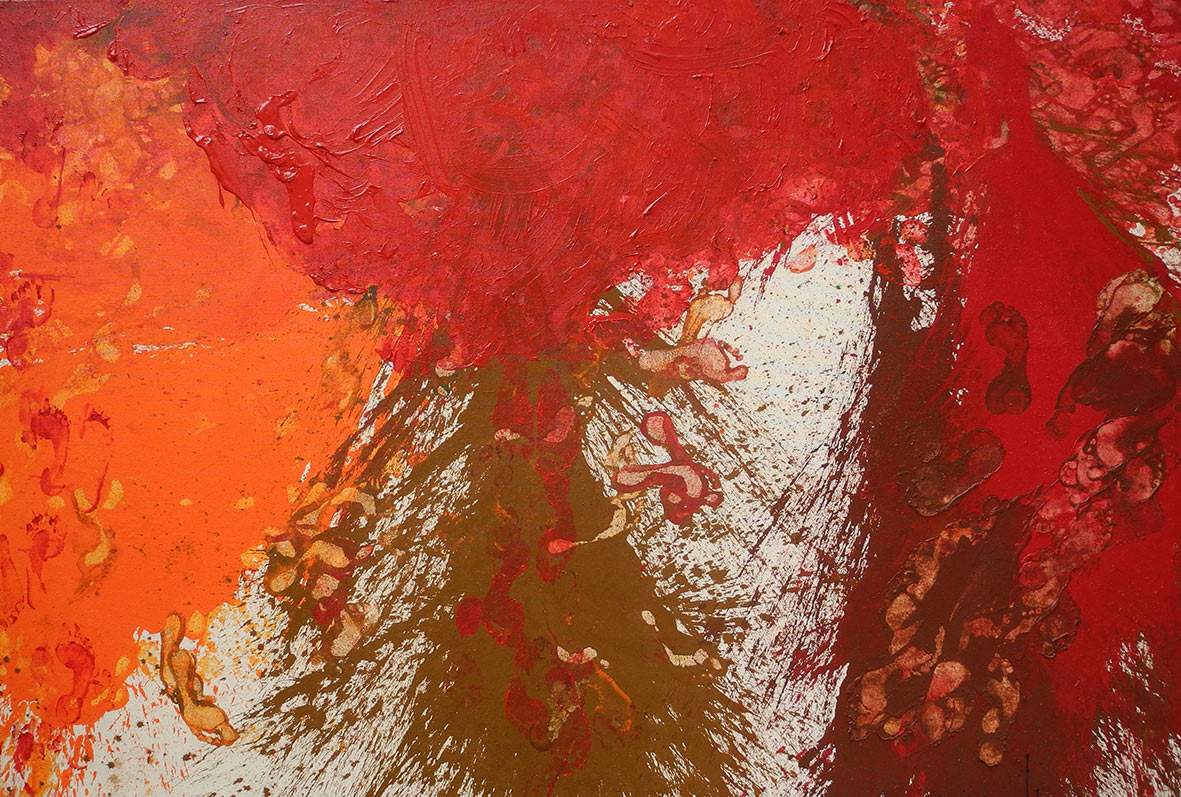From February 24 to April 30, 2022, a major solo exhibition of Hermann Nitsch (Vienna, 1938), the father ofViennese Actionism, is scheduled at Galleria Gaburro in Milan: titled Hermann Nitsch. From Actionism to Painting, it is curated by Lòrànd Hegyi and is the first Nitsch exhibition in northern Italy in more than 22 years. On display are works from the first artistic phase, in which the creations were inextricably linked to the programming of the Theater of Orgies and Mysteries. In addition, the exhibition also hosts works from the last period devoted to the influence of color on the psyche. The wide selection of pictorial works shows several points in common with the overall artistic work. Present are paintings related to action painting, in which Nitsch developed a distinctive action painting marked by ritual acts, also accompanied by objects with strong cultural and ritual connotations, so as to connect symbolic meanings directly with energies and emotions, conveyed through gestural elements.
In particular, the recent works, exhibited for the first time in Italy, reveal a liberating joy and the development of a completely new, variegated and explosive Colorism, with color combinations and hues never before observed in Nitsch.
With his boundless oeuvre, Hermann Nitsch proposes a complex vision of life, spiritual orientation, as well as the meaning of art and the liberating and cathartic potential of artistic experience. In his heterogeneous and multifaceted artistic activity, embodied in painting, drawing, installations, music, performance, theater, writing and poetry, Nitsch claims the inalienability and indissolubility of participation in collective artistic activities (i.e., intense participation within the artistic act), from the perceptual process in its totality. A dramatic, hyperintensive and complex perception, in which the strong sensory impact is closely linked to the activation and actualization of intellectual semantic planes and collective, mythical and archetypal concepts.
In spite of the preeminent role played by the unconscious, that is, the inner psychic reality, in the artist’s thought and work, Nitsch maintains that perception must be actualized, always and everywhere, in the dense cultural and collective context. The artist has always engaged deeply with the specific cultural traditions of his country, such as popular and religious culture, but also with psychoanalysis and Freudian thought. The evidence of thearchetypal and collective element in the emergence and development of the complex symbolic value suggests that aesthetic perception takes place in the common and collective field. Hermann Nitsch’s boundless work can be interpreted in light of the artist’s conception of the “collective archetypal conditions of spirituality” and can be understood in the sphere of unconscious thought. Thus, the entire process of aesthetic perception is inseparable from the archetypal and collective plane (reason why his actions see the presence of spectators), which finds its fulfillment in metaphorical, cultic and ritual acts i.e. aesthetic formations.
The ecstatic experience of the totality of being through the intensity of elemental sensations is precisely a collective act, in which the joyful and liberating identification with life in all its forms is accompanied by the extrusion of collective and archetypal concepts. Nitsch lays claim to the collective and cultural character of such an experience, which can determine the substantive content of any grand mystical narrative about the creation of the world, countering the fear of death, eternal life, resurrection or eternal return. In Nitsch’s work, the archetypal and collective element holds central significance. The artistic practice attempts by all means (through the radicalization of sensuality and the intensification of the immediacy of each physical, sensory-material effect), to activate the collective unconscious in order to bring to light a series of fundamental anthropological realities and relate them to the collective symbolic content. The most basic gestures of the specific informal painting and the actions, embedded in the real time of the Theater of Orgies and Mysteries, reveal their origin in the unconscious. At the same time, it must be clearly reiterated that the unconscious, in Hermann Nitsch’s overall aesthetic conception, is always contextualized in the totality of collective actions. Collective actions, cultic and ritual practices but also mythical and religious narratives refer back to these essential archetypal realities that, in various cultures, innervate the general framework of the organization of life, social actions and relevant axiological systems.
From a historical point of view, it is important that Nitsch’s painting and performance are not so much traceable to the heroic individualism, pessimism of action painting and abstract expressionism (corroborated by existentialist philosophy and influenced by the specific North American development), but to an’anthropological cultural observation, as well as a subjectively revisited Zen-Buddhist philosophy of life and the Christian belief in resurrection, in which the collective perception of the totality of life leads to cathartic self-emancipation and joyful awareness of one’s own perspectives of expression.
For all information visit the Gaburro Gallery website.
Pictured is one of Nitsch’s new works on display at the Gaburro Gallery.
 |
| Major Hermann Nitsch exhibition coming to Milan with previously unseen works |
Warning: the translation into English of the original Italian article was created using automatic tools. We undertake to review all articles, but we do not guarantee the total absence of inaccuracies in the translation due to the program. You can find the original by clicking on the ITA button. If you find any mistake,please contact us.